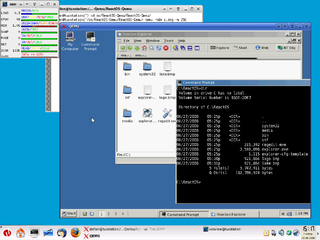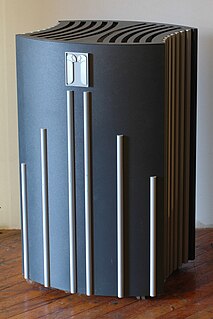Features
ARMulator is written in C and provides more than just an instruction set simulator, it provides a virtual platform for system emulation. It comes ready to emulate an ARM processor and certain ARM coprocessors. If the processor is part of an embedded system, then licensees may extend ARMulator to add their own implementations of the additional hardware to the ARMulator model. ARMulator provides a number of services to help with the time-based behaviour and event scheduling and ships with examples of memory mapped and co-processor expansions. This way, they can use ARMulator to emulate their entire embedded system. A key limitation for ARMulator is that it can only simulate a single ARM CPU at one time, although almost all ARM cores up to ARM11 are available.
Performance of ARMulator is good for the technology employed, it's about 1000 host (PC) instructions per ARM instruction. This means that emulated speeds of 1 MHz were normal for PCs of the mid to late 90s. Accuracy is good too, although it is classed as cycle count accurate rather than cycle accurate, this is because the ARM pipeline isn't fully modeled (although register interlocks are). Resolution is to an instruction, as a consequence when single stepping the register interlocks are ignored and different cycle counts are returned than if the program had simply run, this was unavoidable.
Testing ARMulator was always a time-consuming challenge, the full ARM architecture validation suites being employed. At over 1 million lines of C code it was a fairly hefty product.
ARMulator allows runtime debugging using either armsd (ARM Symbolic Debugger), or either of the graphical debuggers that were shipped in SDT and the later ADS products. ARMulator suffered from being an invisible tool with a text file configuration (armul.conf) that many found complex to configure.
ARMulator II formed the basis for the high accuracy, cycle callable co-verification models of ARM processors, these CoVs models (see Cycle Accurate Simulator) were the basis of many CoVerification systems for ARM processors.
Availability
ARMulator was available on a very broad range of platforms through its life, including Mac, RISC OS platforms, DEC Alpha, HP-UX, Solaris, SunOS, Windows, Linux. In the mid-1990s there was reluctance to support Windows platforms; pre-Windows 95 it was a relatively challenging platform. Through the late 1990s and early 2000s support was removed for all but Solaris, Windows and Linux - although undoubtedly the code base remains littered with pragmas such as #ifdef RISCOS.
ARMulator II shipped in early ARM toolkits as well as the later SDT 2.5, SDT 2.5.1, ADS 1.0, ADS 1.1, ADS 1.2, RCVT 1.0 and also separately as RVISS. Special models were produced during the development of CPUs, notably the ARM9E, ARM10 and ARM11, these models helped with architectural decisions such as Thumb-2 and TrustZone.
ARMulator has been gradually phased out and has been replaced by Just-in-time compilation-based high performance CPU and system models (See FastSim link below).
ARMulator I was made open source and is the basis for the GNU version of ARMulator. Key differences are in the memory interface and services, also the instruction decode is done differently. The GNU ARMulator is available as part of the GDB debugger in the ARM GNU Tools.
ARMulator II formed the basis for the high accuracy, cycle callable co-verification models of ARM processors, these CoVs models (see Cycle Accurate Simulator) were the basis of many CoVerification systems for ARM processors. Mentor Graphic's Seamless have the market leading CoVs system that supports many ARM cores, and many other CPUs.
ARMulator II shipped in early ARM toolkits as well as the later SDT 2.5, SDT 2.5.1, ADS 1.0, ADS 1.1, ADS 1.2, RVCT 1.0 and also separately as RVISS.
Key contributors to ARMulator II were Mike Williams, Louise Jameson, Charles Lavender, Donald Sinclair, Chris Lamb and Rebecca Bryan (who worked on ARMulator as both an engineer and later as product manager). Significant input was also made by Allan Skillman, who was working on ARM CoVerification models at the time.
A key contributor to ARMulator I was Dave Jaggar.
Special models were produced during the development of CPUs, notably the ARM9E, ARM10 and ARM11, these models helped with architectural decisions such as Thumb-2 and TrustZone.

The GNU Debugger (GDB) is a portable debugger that runs on many Unix-like systems and works for many programming languages, including Ada, C, C++, Objective-C, Free Pascal, Fortran, Go, and partially others.

A debugger or debugging tool is a computer program used to test and debug other programs. The main use of a debugger is to run the target program under controlled conditions that permit the programmer to track its operations in progress and monitor changes in computer resources that may indicate malfunctioning code. Typical debugging facilities include the ability to run or halt the target program at specific points, display the contents of memory, CPU registers or storage devices, and modify memory or register contents in order to enter selected test data that might be a cause of faulty program execution.
OpenRISC is a project to develop a series of open-source hardware based central processing units (CPUs) on established reduced instruction set computer (RISC) principles. It includes an instruction set architecture (ISA) using an open-source license. It is the original flagship project of the OpenCores community.
Simics is a full-system simulator used to run unchanged production binaries of the target hardware. Simics was originally developed by the Swedish Institute of Computer Science (SICS), and then spun off to Virtutech for commercial development in 1998. Virtutech was acquired by Intel in 2010 and Simics is now marketed by Wind River Systems, which was in the past a subsidiary of Intel.
JTAG is an industry standard for verifying designs and testing printed circuit boards after manufacture.
Nucleus RTOS is a real-time operating system (RTOS) produced by the Embedded Software Division of Mentor Graphics, a Siemens Business, supporting 32- and 64-bit embedded system platforms. The operating system (OS) is designed for real-time embedded systems for medical, industrial, consumer, aerospace, and Internet of things (IoT) uses. Nucleus was released first in 1993. The latest version is 3.x, and includes features such as power management, process model, 64-bit support, safety certification, and support for heterogeneous computing multi-core system on a chip (SOCs) processors.

QEMU is a free and open-source hypervisor. It emulates the machine's processor through dynamic binary translation and provides a set of different hardware and device models for the machine, enabling it to run a variety of guest operating systems. It can interoperate with Kernel-based Virtual Machine (KVM) to run virtual machines at near-native speed. QEMU can also do emulation for user-level processes, allowing applications compiled for one architecture to run on another.
Nios II is a 32-bit embedded processor architecture designed specifically for the Altera family of field-programmable gate array (FPGA) integrated circuits. Nios II incorporates many enhancements over the original Nios architecture, making it more suitable for a wider range of embedded computing applications, from digital signal processing (DSP) to system-control.
The MicroBlaze is a soft microprocessor core designed for Xilinx field-programmable gate arrays (FPGA). As a soft-core processor, MicroBlaze is implemented entirely in the general-purpose memory and logic fabric of Xilinx FPGAs.
V850 is a 32-bit RISC CPU architecture produced by Renesas Electronics for embedded microcontrollers. It was designed by NEC as a replacement for their earlier NEC V60 family, and introduced shortly before NEC sold their designs to Renesas in the early 1990s. It continues to be developed by Renesas as of 2018.
An instruction set simulator (ISS) is a simulation model, usually coded in a high-level programming language, which mimics the behavior of a mainframe or microprocessor by "reading" instructions and maintaining internal variables which represent the processor's registers.

In integrated circuit design, hardware emulation is the process of imitating the behavior of one or more pieces of hardware with another piece of hardware, typically a special purpose emulation system. The emulation model is usually based on a hardware description language source code, which is compiled into the format used by emulation system. The goal is normally debugging and functional verification of the system being designed. Often an emulator is fast enough to be plugged into a working target system in place of a yet-to-be-built chip, so the whole system can be debugged with live data. This is a specific case of in-circuit emulation.
A computer architecture simulator is a program that simulates the execution of computer architecture.
Segger Microcontroller, founded in 1992, is a private company active in the industry of embedded systems. It provides products used to develop and manufacture embedded systems, in 4 categories: real-time operating systems (RTOS) and software libraries (middleware), debugging and trace probes, programming tools and in-system programmers. The company is headquartered in Monheim am Rhein, Germany. Remote offices are located in Gardner, Massachusetts; Milpitas, California; and Shanghai, China.

In computing, an emulator is hardware or software that enables one computer system to behave like another computer system. An emulator typically enables the host system to run software or use peripheral devices designed for the guest system. Emulation refers to the ability of a computer program in an electronic device to emulate another program or device.

Verilator is a free and open-source software tool which converts Verilog to a cycle-accurate behavioral model in C++ or SystemC. It is restricted to modeling the synthesizable subset of Verilog and the generated models are cycle-accurate, 2-state, with synthesis semantics. As a consequence, the models typically offer higher performance than the more widely used event-driven simulators, which can process the entire Verilog language and model behavior within the clock cycle. Verilator is now used within academic research, open source projects and for commercial semiconductor development. It is part of the growing body of free EDA software.
OVPsim is a multiprocessor platform emulator used to run unchanged production binaries of the target hardware. It has public APIs allowing users to create their own processor, peripheral and platform models. Various models are available as open source. OVPsim is a key component of the Open Virtual Platforms initiative (OVP), an organization created to promote the use of open virtual platforms for embedded software development. OVPSim requires OVP registration to download.





